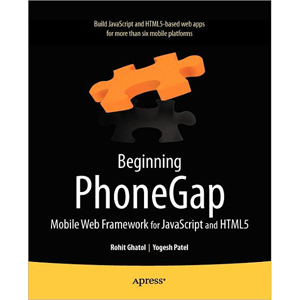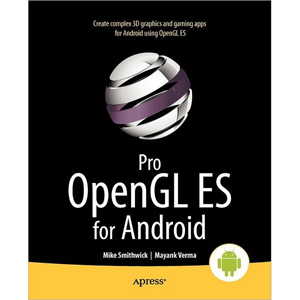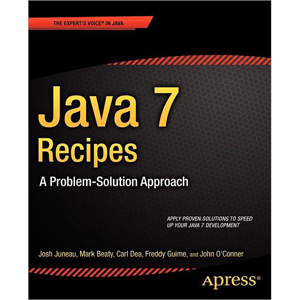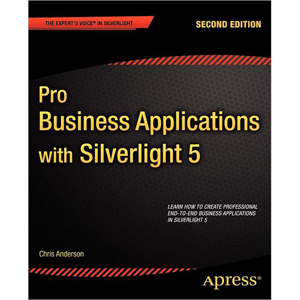5 new posts |  |
- Beginning PhoneGap: Mobile Web Framework for JavaScript and HTML5
- Pro OpenGL ES for Android
- packetC Programming
- Java 7 Recipes: A Problem-Solution Approach
- Pro Business Applications with Silverlight 5, 2nd Edition
| Beginning PhoneGap: Mobile Web Framework for JavaScript and HTML5 Posted: 03 Mar 2012 06:54 AM PST
Book DescriptionPhoneGap is a growing and leading open-source mobile web apps development framework that lets developers build JavaScript and HTML5-based web applications with native wrappers for more than six mobile platforms, including iOS, Android, and BlackBerry. This framework lets you build HTML- and JavaScript-based apps and still take advantage of native mobile device capabilities like camera, localStorage, geolocation, storage and much more, irrespective of the mobile platform you target. It also lets you use more specialized JavaScript frameworks like jQuery Mobile and more. Beginning PhoneGap is a definitive, one-of-a-kind book that teaches the fundamentals and strategies behind cross-platform mobile application development. Instead of learning languages like Objective-C, focus on building apps from day one for Android, iOS, Blackberry, WebOS and Symbian—without the complexities of these platforms. This book shows how to build apps which makes use of Google Local Search to create a Restaurant finder apps (which uses Maps to layout locations and uses internal database to store your favorite restaurants. Furthermore, you’ll learn how to extend PhoneGap’s functionality by using PhoneGap plugins to write apps like Dropbox (syncing files in the background outside HTML/JavaScript code and in native code). By the time you finish Beginning PhoneGap, you’ll know PhoneGap inside and out, and, consequently, be able to develop mobile web apps faster and more efficiently than ever before. Make more money in less time! What you'll learn
Who this book is for Table of Contents
Book Details
Related Posts
|
| Posted: 03 Mar 2012 06:49 AM PST
Book DescriptionIn Pro OpenGL ES for Android, you’ll find out how to harness the full power of OpenGL ES, and design your own 3D applications by building a fully-functional 3D solar system model using Open GL ES! OpenGL has set the standard for 3D computer graphics, and is an essential aspect of Android development. This book offers everything you need to know, from basic mathematical concepts to advanced coding techniques. You’ll learn by building a fascinating 3D solar system simulator! After introducing Open GL ES, Pro OpenGL ES for Android explains the basics of 3D math and then orients you to the native Android 3D libraries you’ll be using in your own 3D games and the solar system project you’ll build using this book. Through the solar system example project, you’ll learn how to incorporate a variety of graphic and animation techniques into your applications. You will also discover how the full spectrum of 3D development that awaits, with topics such as lighting, texture-mapping, modeling, shaders, blending modes, and several more advanced concepts. By the time you finish Pro OpenGL ES for Android, you’ll have learned all the skills you’ll need to build your own incredible 3D applications, based on one of the most powerful 3D libraries available. What you'll learn
Who this book is for Table of Contents
Book Details
Related Posts
|
| Posted: 03 Mar 2012 06:46 AM PST
Book DescriptionThis book introduces the tools you’ll need to program with the packetC language. packetC speeds the development of applications that live within computer networks, the kind of programs that provide network functionality for connecting “clients” and “servers" and "clouds.” The simplest examples provide packet switching and routing while more complex examples implement cyber security, broadband policies or cloud-based network infrastructure. Network applications, such as those processing digital voice and video, must be highly scalable, secure and maintainable. Such application requirements translate to requirements for a network programming language that leverages massively-parallel systems and ensures a high level of security, while representing networking protocols and transactions in the simplest way possible. packetC meets these requirements with an intuitive approach to coarse-grained parallelism, with strong-typing and controlled memory access for security and with new data types and operators that express the classic operations of the network-oriented world in familiar programming terms. No other language has addressed the full breadth of requirements for tractable parallelism, secure processing and usable constructs. The packetC language is growing in adoption and has been used to develop solutions operating in some of the world's largest networks. This important new language, packetC, has now been successfully documented in this book, in which the language’s authors provide the materials and tools you’ll need in a readable and accessible form. What you'll learn
Who this book is for Table of Contents Part 2: Language Reference Part 3: Developing Applications Part 4: Industry Reprints Book Details
Related Posts
|
| Java 7 Recipes: A Problem-Solution Approach Posted: 03 Mar 2012 06:39 AM PST
Book DescriptionJava 7 Recipes offers solutions to common programming problems encountered every day while developing Java-based applications. Fully updated with the newest features and techniques available, Java 7 Recipes provides code examples involving Servlets, Java FX 2.0, XML, Java Swing, and much more. Content is presented in the popular problem-solution format: Look up the programming problem that you want to solve. Read the solution. Apply the solution directly in your own code. Problem solved! The problem-solution approach sets Java 7 Recipes apart from other books on the topic. Java 7 Recipes is focused less on the language itself and more on what you can do with it that is useful. The book respects your time by always focusing on a task that you might want to perform using the language. Solutions come first. Explanations come later. You are free to crib from the book and apply the code examples directly to your own projects.
What you'll learn
Who this book is for Table of Contents
Book Details
Related Posts
|
| Pro Business Applications with Silverlight 5, 2nd Edition Posted: 03 Mar 2012 06:36 AM PST
Book DescriptionSilverlight 5 has the potential to revolutionize the way we build business applications. With its flexibility, web deployment, cross-platform capabilities, rich .NET language support on the client, rich user interface control set, small runtime, and more, it comes close to the perfect platform on which to build business applications. It's a very powerful technology, and despite its youth, it's moving forward at a rapid pace and is gaining widespread popularity. This book guides you through the process of designing and developing enterprise-strength business applications in Silverlight 5 and C#. You’ll learn how to take advantage of the power of Silverlight to develop rich and robust business applications—from getting started to deployment, and everything in between. In particular, this book will serve developers who want to learn how to design business applications. It will introduce the patterns you’ll use, the issues you'll face, and how to resolve them. Author Chris Anderson, who has been building line-of-business applications for years, demonstrates his expertise through a candid presentation of how to tackle real-life issues, rather than just avoiding them. Developers will benefit from his hard-won expertise through business application design patterns that he shares throughout the book. With this book in hand, you will:
What you'll learn
Who this book is for Table of Contents
Book Details
Related Posts
|
| You are subscribed to email updates from Wow! eBook - Blog To stop receiving these emails, you may unsubscribe now. | Email delivery powered by Google |
| Google Inc., 20 West Kinzie, Chicago IL USA 60610 | |






Tidak ada komentar:
Posting Komentar